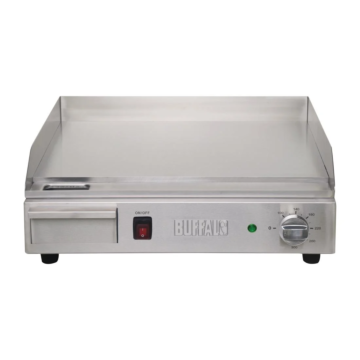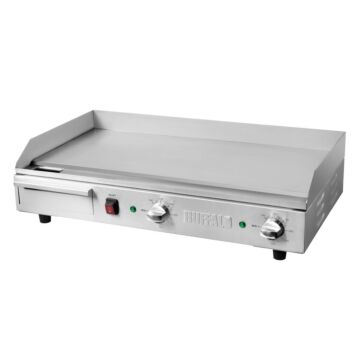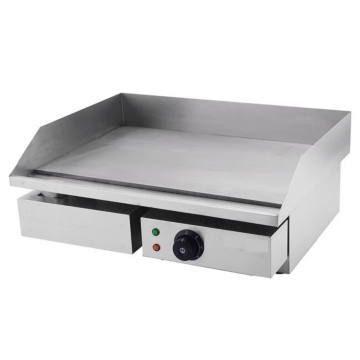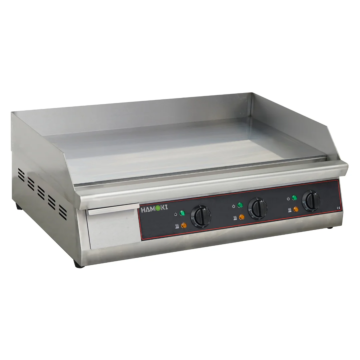Shop 2 stores as 1 | Shared Search, Account & Cart
Checkout using your account
Checkout as a new customer
Creating an account has many benefits:
- See order and shipping status
- Track order history
- Check out faster
Commercial Griddles
Griddles provide the ideal cooking surface for a wide variety of ingredients and are an essential item for the majority of professional kitchens. With a choice of materials and finishes, commercial grills & griddles from leading catering brands can guarantee professional results with every use.
Need help selecting the ideal equipment?

- Cooking Area 525 x 330
- Temperature Range 60C to 200C
- Colour Silver
- Footing Countertop
- Kilowatts 2.2 Show More
Minimum order value £1000 ex VAT

- Footing Feet
- Grill Material Steel
- SKU DB167
- Warranty Cover 24 Months Parts & Labour
- Delivery Standard 1 to 3 Working Days Show More
Minimum order value £1000 ex VAT

- Temperature Range 50C to 300C
- Footing Feet
- Kilowatts 3
- SKU 101020
- Warranty Cover 12 Months Parts Only Show More
Minimum order value £1000 ex VAT

- Cooking Area 756 X 400
- Temperature Range 50C to 300C
- Footing Feet
- Kilowatts 6
- SKU 101100 Show More
Minimum order value £1000 ex VAT

- Cooking Area 1500 x 482
- Footing Feet
- Gas kW 37.50kW
- SKU 101082
- Warranty Cover 12 Months Parts Only Show More
Minimum order value £1000 ex VAT

- Footing Feet
- Gas kW 37.50kW
- SKU 101082-P
- Warranty Cover 12 Months Parts Only
- Delivery Standard 1 to 3 Working Days Show More
Minimum order value £1000 ex VAT
Commonly Asked Questions About Commercial Griddles
Which is better, a gas or electric griddle?
The majority of professional kitchens should have a commercial griddle as part of their set-up due to their versatility. Choosing between electric and gas commercial kitchen griddles for your business hinges on your needs. Commercial gas griddles heat up fast, recover temperatures more quickly and reacts quickly to temperature changes, perfect for high-heat cooking. Heavy duty electric griddles offer convenience and energy efficiency, with smaller models are especially suited to mobile catering. Your choice of gas and electric should align with your kitchen's demands, including cooking speed, temperature precision, and installation feasibility.
What is the difference between ribbed and smooth plate griddles?
The difference between ribbed and smooth griddles lies in their design, finish and functionality. A ribbed plate griddle, often found in commercial countertop griddles and large commercial griddles, has grooves that allow juices and fats to drain away from the food, promoting healthier cooking and giving the ingredients attractive grill marks. Meanwhile, a smooth griddle provides a flat cooking area that's easy to clean and ideal for evenly cooking pancakes, eggs, and any items requiring a flat surface. The choice between ribbed and smooth depends on the specific needs of your menu and the types of dishes you plan to prepare.
Is a griddle the same as a plancha?
Griddles and planchas use similar flat heated areas and are both used in commercial catering kitchens but have notable differences. Planchas reach higher temperatures, which is ideal for searing and achieving a sealed crust. Planchas have concentrated heat over the burner, and often manual controls, allowing for high-temperature cooking, while griddles offer even heat distribution and temperature control via a sensor. Although sometimes a restaurant griddle may be called a plancha, they serve distinct culinary functions, favouring the plancha for its high-heat searing capabilities.
Why cook on a griddle instead of a grill?
Cooking on a commercial countertop griddle offers a versatile culinary experience compared to a traditional grill. The flat plate of a griddle is perfect for various cooking techniques, such as frying, steaming, and sautéing, which are not feasible on a grill's open grate. Grills are primarily designed for grilling or searing, imparting a smoky flavour to the food, but they can't efficiently cook produce, such as eggs, that require a solid griddling base. A professional griddle is a valuable tool in any commercial kitchen, enabling chefs to prepare a diverse menu, from pancakes to steaks, with ease and efficiency.
What is the best material for a griddle plate?
When buying commercial catering griddles, the choice of plate material—cast iron, steel, chrome, or ceramic glass—significantly impacts heat dynamics and culinary results. Cast iron excels in heat retention and even distribution, essential for uniform cooking, but requires seasoning for rust prevention and non-stick properties. Steel plates, particularly carbon steel, is valued for its rapid heating and adaptability to temperature changes, though it may fall short in heat retention compared to cast iron. Chrome-plated griddles offer energy efficiency and ease of cleaning with their reflective and smooth cooking areas but may not achieve the same searing quality. Ceramic glass, a newer option, heats swiftly and offers a modern, easy-to-clean surface yet lacks the robustness of metal plates. The optimal material for a griddle plate hinges on the kitchen's specific demands, balancing durability, heat management, and maintenance needs.
How thick should a griddle plate be?
You should choose the thickness of your cooking area based on your needs. Thicker plates, such as those 25mm or more, are excellent for heat retention and even distribution, making them ideal for a ribbed griddle used for searing meats and grilling vegetables. They are suitable for cooking large batches of ingredients without significant temperature fluctuations. On the other hand, thinner plates, around 12mm or less, heat up more quickly and are easier to manoeuvre, which can be advantageous for a smooth griddle when preparing delicate dishes like crepes.
Should I season a griddle?
If you’re looking for a commercial griddle for sale for your kitchen, knowing how to look after your purchase is vital; therefore, seasoning your unit is essential. Seasoning forms a non-stick layer that prevents produce from sticking, shields the cooking area from rust, and makes cleaning easier after use. Using oil with a high smoke point is recommended for the process. A full seasoning should be done before the first use and then periodically to maintain the coating. After each cleaning, apply a lighter coat of oil to preserve the commercial kitchen griddle's condition. Seasoning ensures the longevity and performance of the catering equipment, making it a reliable tool in any industrial kitchen setting.
What are heat zones and should my griddle have them?
Heat zones on a large commercial griddle or flat top griddle are distinct areas that can be controlled independently for temperature. The heat zone feature is particularly beneficial when cooking multiple ingredients simultaneously, as it allows different sections to be set at varying temperatures. For instance, one zone can be at a higher temperature for searing meats, while another can be lower to cook vegetables gently. Controlling each zone ensures greater precision and flexibility, enhancing the cooking process and food quality. It's a valuable feature for any busy professional kitchen where chefs prepare various dishes must be prepared simultaneously.
What does recovery time mean?
"Recovery time" in the context of griddles and professional griddles refers to the period it takes for the cooking surface to return to the desired operating temperature after cold food, particularly chilled produce, has been placed on them. It's a critical factor because a quick recovery time ensures consistent cooking temperatures and efficient service, especially during peak hours in a catering kitchen setting. A unit with a fast recovery time will maintain heat better, allowing chefs to cook successive batches of food without significant delays or temperature drops.
What are heat zones and should my griddle have them?
Heat zones on a large commercial griddle or flat top griddle are distinct areas that can be controlled independently for temperature. The heat zone feature is particularly beneficial when cooking multiple ingredients simultaneously, as it allows different sections to be set at varying temperatures. For instance, one zone can be at a higher temperature for searing meats, while another can be lower to cook vegetables gently. Controlling each zone ensures greater precision and flexibility, enhancing the cooking process and food quality. It's a valuable feature for any busy professional kitchen where chefs prepare various dishes must be prepared simultaneously.
Why does my food have black bits on it from my cast iron griddle plate?
The black bits on your food from a cast iron griddle are likely residual burnt food particles, not the griddle's coating. Deposits can happen if the equipment isn't cleaned properly after use. To prevent this, wash your catering griddle thoroughly after each use. Whether you have a smooth griddle or a ribbed griddle, regular maintenance is critical to avoiding the accumulation of burnt residue and ensuring delicious, clean results every time you cook.
What can I cook on a commercial griddle?
On a commercial griddle grill or restaurant griddle, the possibilities are nearly endless. You can cook a huge variety of foods to perfection, including fish, meat, vegetables, pancakes, and flatbreads, even a full breakfast menu including bacon, sausage, mushrooms, black pudding, eggs and hash browns. The even flat plate griddle surface is ideal for achieving a consistent cook on everything from breakfast staples to dinner entrees, making it an indispensable piece of equipment in any professional kitchen. Whether flipping burgers or crafting delicate crepes, the equipment's versatility is a chef's ally in menu diversity and culinary creativity.
Are griddles healthier than chargrills?
Cooking on a commercial countertop griddle is often considered healthier than chargrills because the flat or ribbed surface allows fat to run off and away from produce on the griddle. In contrast, on a chargrill, fat drips through the grates onto the open flame and vaporises, which can cause flare-ups and potentially carcinogenic char. Always ensure that grease can drain freely to prevent any soaking up of fat, which is not good for you. Therefore, while griddles can be healthier due to less charring, attention to grease management is key to maximising health benefits.
What's the difference between a griddle, a contact grill, a chargrill and a salamander grill?
Each of these types of equipment performs crucial tasks, using differing methods of cooking. While griddles heat from beneath on a solid plate, chargrills heat from beneath on an open grid. Contact grills and panini grills produce results through direct contact with produce from above and below. Salamander grills typically heat from above however some models are available with both, bottom and top heating elements.
